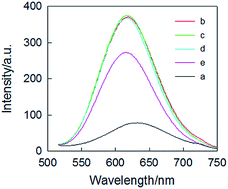A nucleic acid cleavage-based fluorescent probe for the detection of copper ions in pure aqueous solution†
Abstract
Herein, a novel carbazole derivative of BEVC was designed with an enhanced fluorescence signal by a G-quadruplex, and thus a fluorescent probe of G-quadruplex/BEVC was obtained by aggregation-induced emission, which could exhibit a decreased fluorescence signal in the presence of Cu2+via the Fenton reaction, demonstrating great potential for Cu2+ assay in pure aqueous solution.



 Please wait while we load your content...
Please wait while we load your content...